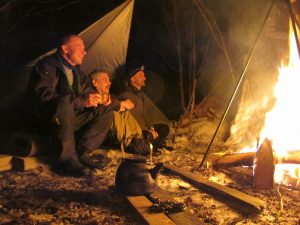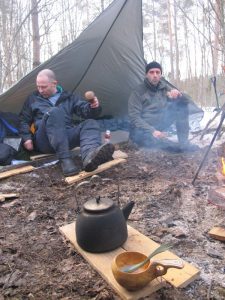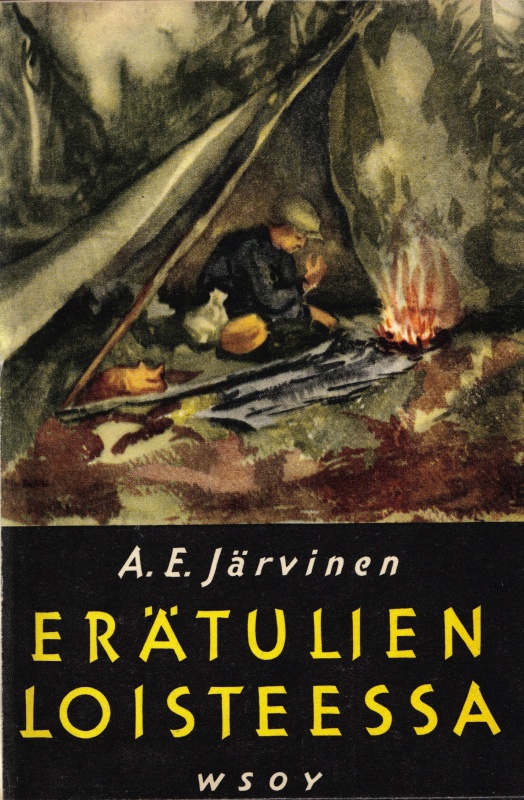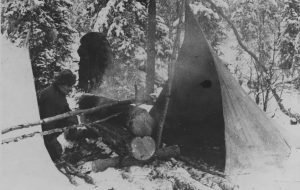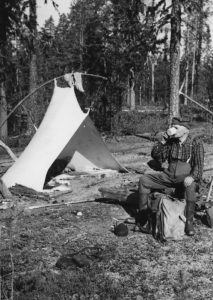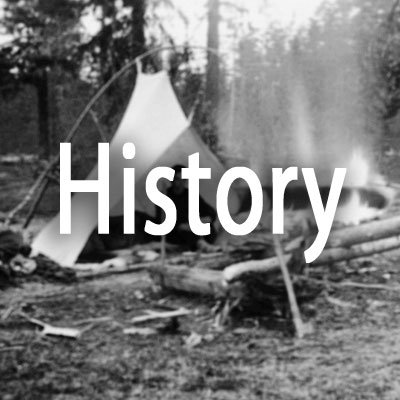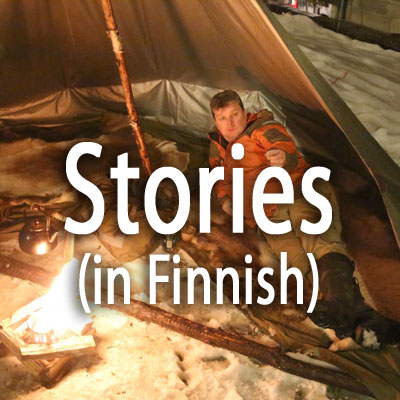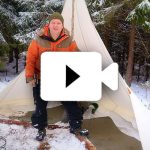Loue is the only open-fire-shelter, that is truly Finnish. The useful fabric has a long and interesting past, which I have always found fascinating.
Loue is a fabric, that is wedge-shaped from the front, and round-shaped from the back. The top of the fabric can be placed hanging from a pole, or tied to a tree. The curve-shaped behind of the fabric is attached to the ground with tent pegs.
This type of Loue (As seen in the photo) has served Finnish woodsmen for over 80 years. During the last few years, the amount of Loue-users has been decreasing, but the shelter is still available to buy. Besides, nowadays, when people are going retro, maybe the Loue will be found again and have a renaissance.
For me, Loue has been an important part of outdoors for decades. In my first scout camps, we slept in canvas shelters, because many boys would fit in there. Our leaders used a Loue, as two persons can fit there perfectly. I believe that the desire to become a scout leader and to sleep in a Loue is the reason for my enthusiasm for them.
The only truly Finnish open-fire-shelter.
A canvas lean-to is surely more popular than a loue these days. I have spent more nights in a lean-to than in a loue.
Finnish people usually claim, that they invented the lean-to, and say it’s the perfect shelter for winter. When I started investigating the roots of open-fire-shelters, I soon found out, that the design of a lean-to appeared in American literature over 100 years ago. So, unfortunately, a lean-to is not invented in Finland.
The shape of a lean-to appears over the world in many cultures. They are wood-made, covered with branches or leaves, whatever was available.
Of course we have done lots of modifications to the Lean-to, but it’s not originally from Finland. Not even from Scandinavia, although a lean-to of same design can be found from Sweden. The Swedish model is called Vindskydd.
Searching the archives
In Finnish literature, the loue has also been called Malli Järvinen (The model of Järvinen). That’s because the designer of the current loue-model was a man named Aarne Erkki Järvinen. He worked for the Finnish Ministry of Forests. A.E. Järvinen also spent his free- time in the forest, hunting and painting. In the forest he also got the inspiration to write novels, and he became one of the most famous outdoor-novelists.
A.E. Järvinen’s trademark was sleeping by a log fire, and under a loue-shelter. I went to Riihimäki hunting-museum, where I could investigate the archives. I found the very first article about a loue. It was from a Hunting and Fishing Magazine from 1931. In the article A.E. Järvinen was introducing his invention, the loue.
He wrote:
”Those, who want to spend their night by a log fire, are naturally carrying an axe with them. But it is also very important to have a loue-fabric, a protector from the wind and rain. A loue-shelter is placed near the campfire. This shelter makes the log fire perfectly safe.”
There was also three simple drawings in the article. The drawings showed the cone-like shape of the loue. After this article was published, many people got interested. In 1934 A.E. Järvinen wrote another article for the magazine. This time with clearer instructions and pictures.
”The best and the most practical shape for a loue is the one I have described in my earlier articles”, wrote A.E. Järvinen.
”A shelter like this is good for a small group of 1-3 persons. You sleep on the ground diagonally, with your feet facing the fire. It is very light and spacious. A good shelter for the rain with no smoke. You can build it quickly and easily any time of the year.”
”When the log fire is near enough, and the shelter is correctly built, it is warm under the Loue. As warm as in a proper house!” tells Järvinen at the end of his article.
A.E. Järvinen continued developing the loue and
spreading information about it. In 1937 he once again wrote to the magazine.
”Heavy rains and mosquitoes are the greatest enemies of a hiker. You can only survive with a loue and a mosquito-net.”
”A shelter like this guarantees comfort, no matter if the weather was bad. You can make a campfire, which brings warms you up, and dries your wet clothes. After removing the mosquito-net, you can easily make food or just sit back.”
Wartimes cut the story of Loue
The last article, that A.E. Järvinen wrote was published in a military- magazine called Hakkapeliitta in 1939. The text is the same as in previous articles, but the pictures had been redrawn.
It is not known, how much the Finnish soldiers used the Loue during the Second world war.
The Finnish soldiers were excellent at forest battles. They taught some woodland skills to German soldiers. Part of this training was to learn how to build a shelter.
After the wars, Finnish people worked hard to pay the Russians their war reparations. That’s why people didn’t have time to go outdoors in their free-time.
During the years, loue started to return from the oblivion. In 1960s The Boy Scout’s equipment- store sold the first fabrics, that were specially designed for loue-use.
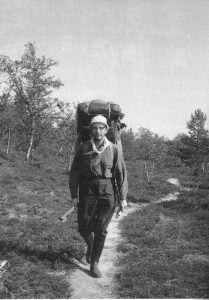
Kemppinen brings it back.
Novelist Kullervo Kemppinen is surely the greatest revitalizer of the loue- culture. This Boy Scout-author was famous for his Lapland-themed books. In 1961 he wrote a book called Poropolku kutsuu. In the book he tells, how he has gotten tired of normal lean-tos, and has started using a Loue.
”After I returned from the hike, I received the blueprints Hersu friend of mine had promised me. The prints of the authentic Loue, designed by A.E. Järvinen himself. Just looking at the pictures got me interested.”
Kemppinen went on a hike with three of his friends. They erected two
homemade loues facing each other and made on campfire between them.
He then wrote how practical and cosy it was. ”When it’s raining you can
truly see the best side of loue”, he tells. ”You can place the loue against the wind, so the rain won’t bother your night.”
”Rainy days loue set up against to wind and under it we are fully safety. All works like drying wet clothes, repairing them, until cooking and coffee making you can do in sitting under loue shelter. Log fire doesn’t need care it burning whole night. And when bag packs get space under canvas all what you need are get at able by hands.”
In 1966 Kemppinen published a 500-page book, called Eräretkeily.The book contained all kinds of information about outdoor-life, for example camping equipment. All kinds of outdoor shelters are presented on the book, and the blueprints of loue really stand out from other shelters.
Kemppinen had written a small text on the blueprints. ”You can attach a 50 centimetre long skirt to the bottom of the canvas to protect you from the wind.”
A Remarkable discovery from Tankavaara
I had examined many kinds of amateur- and professional-made loues, but I couldn’t understand what Kemppinen meant with the ”skirt.” None of the loue-makers had used the skirt.
I had visited Kemppinen a some years ago, but I didn’t know to ask him that. Kemppinen passed away in 2012, so I couldn’t go and ask him.
However, Kemppinen’s son told me, that his father had donated some of his outdoor-equipment to the Urho Kekkonen National Park in Lapland.
I contacted the National Park. Unfortunately they didn’t have the loue in their collection. They had all other kinds of stuff, including Kemppinen’s rucksack, that was never opened by the National Park staff.
I asked the Park staff to look inside the rucksack, and there it was – the original loue made by Kemppinen. Her wife Laila had stitched it 50 years ago, and the last 20 years it had been inside a rucksack without anyone knowing.
I travelled to Lapland to see this remarkable discovery. The canvas was brown nylon and after all these years it still felt strong. The stitching was clearly homemade, but very ably done. I carefully laid the loue to the floor. I measured every side of the canvas and took lot’s of photographs. After my operation, the remarkable piece of canvas was put back into the rucksack.
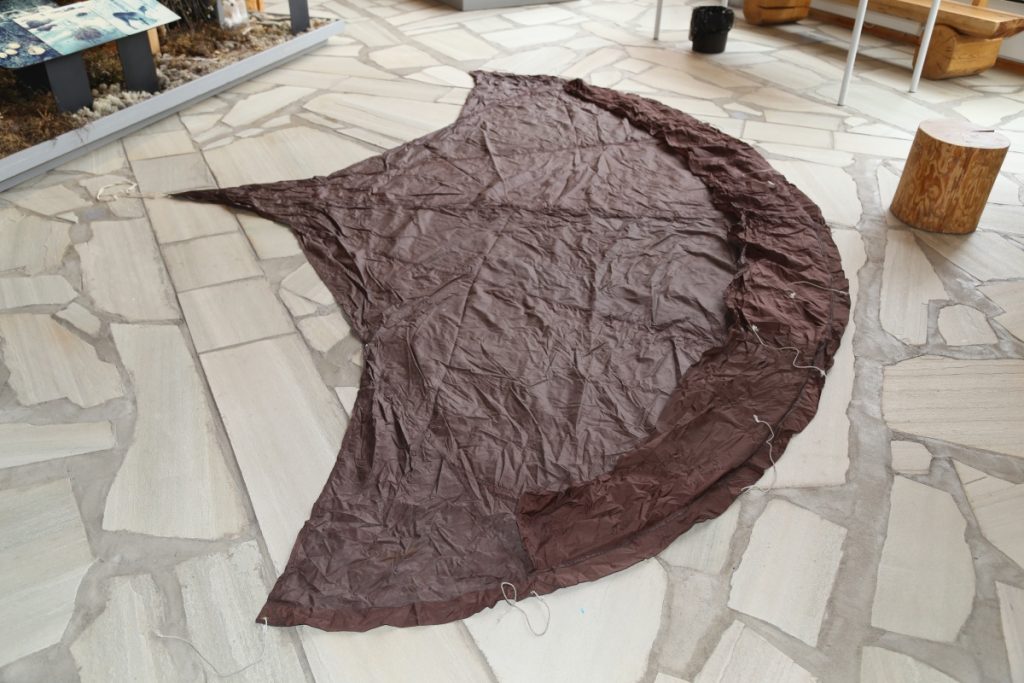
Later the National Park museum staff found a list of Kemppinen’s donations. The Loue was also listed.
”Brown loue: The model and measurements based on the design by A.E. Järvinen. Shelter for two people. Used many times in outdoors. Weight about 1 kg. ”
The chocolate-brown Loue I found from Tankavaara also revealed the correct way to use the ”skirt” Kemppinen had mentioned.
Unlike in the modern Loue, the older model had no peg loops. Instead it had ropes. With the ropes you can lift the whole side off the ground, so it’s useful to have the extra skirt to get more space.
By using the ropes you can adjust the height of the loue’s backside. If the loue would be attached to the ground with tent pegs, the height of the canvas wouldn’t be so easy to adjust. By adjusting the height of the back wall, you can get a lot more room to your shelter.
When the skirt is stitched a few centimetres from the eaves of the canvas, the rain won’t get in. The skirt can be folded under the ground sheet, so the wind won’t bother you either. The skirt Kemppinen designed was a small addition to the loue, but it is actually very useful.
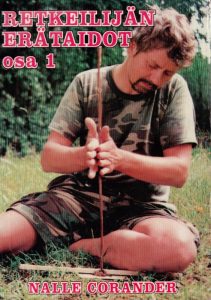
Loue’s final stand
But let’s return back to the milestones of the loue-history. When Kemppinen’s generation stopped camping in the 1980s, the modern outdoor-equipments became more popular. People preferred new hiking-tents over old fashioned open-fire-shelters.
Nylon shelters were still used by Scouts and some hikers, but the traditional loue-shelter was almost completely forgotten.
Loue was mentioned in couple of Scout-books by Olli Aulio in 1976 and 1990, but otherwise the loue was missing from outdoor books.
In 1994 a member of the Survival Guild called Björn ”Nalle” Corander published an outdoor book he had written. In the book loue has returned to the place it deserves. The book included the same kind blueprints as in the previous books.
Corander stitched his own loues, and put those in sale, but not many people bought those. Corander also made loues for 4 persons. The same model, but little bit bigger.
As tents and modern gear became more popular, there were just some small companies that still made loue shelter by nylon.
In honour of old Finnish outdoor traditions, the Finnish Wilderness Skills Association has made a selection of three different loues. The loues are made out of nylon, polyester and cotton and they are made by using the original blueprints by A.E. Järvinen.
Every model includes the eyelets, the leather reinforcements and the skirt Kemppinen had designed. One of the loues is the bigger model for 4 persons as designed by Corander.
Traditional outdoor-skills are getting more popular these days, so some people say that the loue might return to the use of Finnish woodsmen. Loue is the only shelter, that can stand the cold Finnish winter.
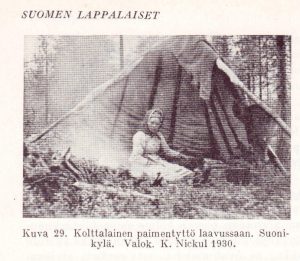
Wonderful for wintertime
In Finland many people believe a fabric lean-to is an excellent winter shelter. That’s not true. A.E. Järvinen wrote: ”Usually, in a lean-to, you sleep with your feet facing the fire. In that position you don’t get very warm.”
In a loue you sleep diagonally with your side facing the fire, so your whole body gets warm. The canvas also reflects the heat more than the canvas in a lean-to.
”I have tried a fabric lean-to once. Probably I built it wrong, because I only got smoke in my eyes and it didn’t protect me from the wind…”
Kemppinen tells his opinion about a lean-to.
As Kemppinen said, the smoke is a common thing you have, when sleeping in a lean-to. In a loue the top part of the canvas releases the smoke, so it doesn’t disturb you.
The great thing about loue is, that you can adjust the height of the canvas. When it’s raining, the canvas is placed lower to shelter you. In a cold weather the canvas is placed much higher to reflect the heat of the campfire.
The name ”loue” is sami language and means a shelter with an open side. Two loues make placed facing each other is ”Lavvu.”
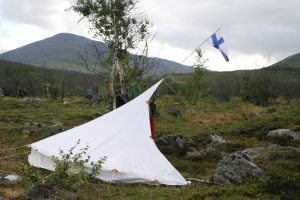
What are loues made of?
”The loue-fabric is usually made out of normal cloth. A wide piece of canvas is easy to use. Do not oil the canvas, as it would only make it more heavy”, wrote A.E. Järvinen.
Kemppinen has mentioned a scout-tent-canvas in his books. He probably means a thin piece of cotton. For those who want the shelter to be light, he recommended nylon, which was a brand new product back then.
The modern loue is usually nylon with a silvered inside. A polyester-loue weighs more, but can stand hard weathers better than a nylon-version.
The material doesn’t really matter in the end, as long as you understand the features. The lightest one isn’t the strongest one, but much more comfortable to carry.
For this article we made a cotton-loue with the leather reinforcements. It was based exactly on the model by
Kemppinen. The Vintage-loue weighs about 3,3 kilograms, as the same size nylon-loue weighs 900 grams.
I personally, person who likes heritage outdooring and traditional style, rather carried the heavier version with me, when I went to the forest, up to Lapland mountains. Only just because the cotton- loue is much more traditional and it looks very beautiful.
The size of the loue has remained the same throughout the years. The same measurements have been in all of the book and blueprints. In 85 years there hasn’t been much changes in the loue- desing.
I think that proofs, that A.E. Järvinen’s invention is perfect and unbeatable. A product, that suits the Finnish nature and Finnish people.
How using the Loue
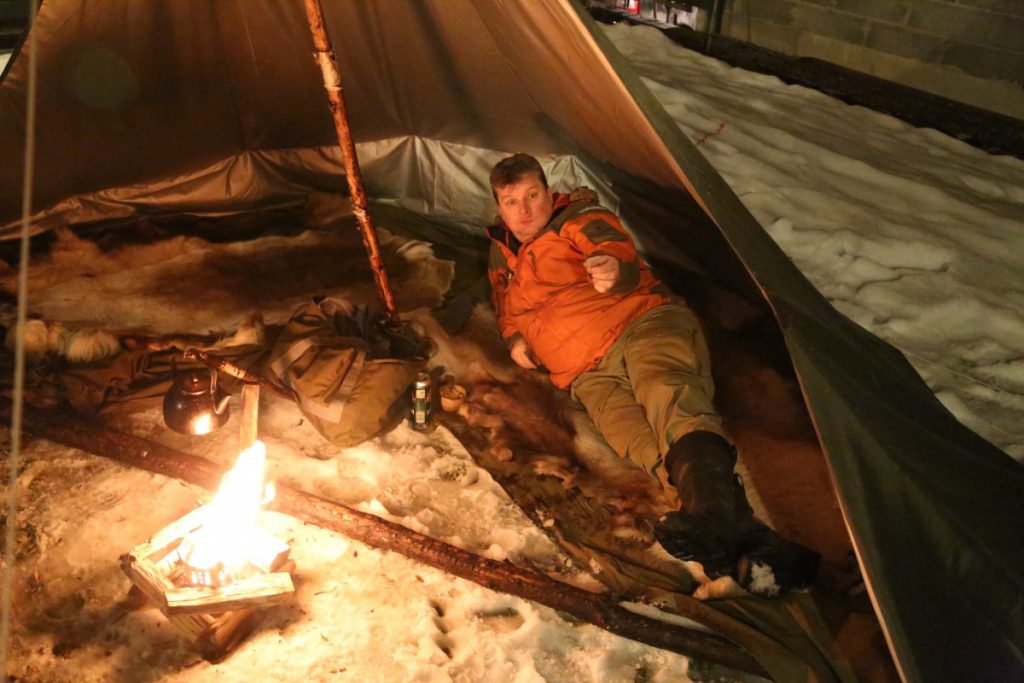
”It’s very easy and simple to erect. The canvas can be hung from a pole or a tree. The other side of the canvas is attached to the ground with ten pegs”, writes Järvinen.
”The loue should be placed with it’s backside facing the wind diagonally, so it doesn’t completely stop the wind. The wind is good to keep the smoke away.”
Traditionally, you should put spruce twigs into the loue, as the
groundsheet. ”The spruce twigs have to be placed carefully overlap. Then you can nicely fall asleep on your softwood-bed.”
In front of the loue you place a so called ”doorstep-wood”, which protects you from rolling into the fire in your sleep. It also protects the spruce twigs, so they won’t catch fire. It’s also nice to sit on the wood while you’re cooking at the campfire.
Since the beginning, loue-users have made a log-fire by their shelter. In summertime, when it’s warmer, you could also burn a hobo stove instead of a campfire. The firewood is kept near the pole, so it’s easy to throw the wood into the flames.
In summertime it is very useful to attach a mosquito net to your loue.
The loue can be used as a shelter in day or night. You can use the canvas to shelter your equipment of contain something. Several loues can be placed facing each other with one campfire. There are many alternatives, because the loue is made for people to use.
 Loue
Loue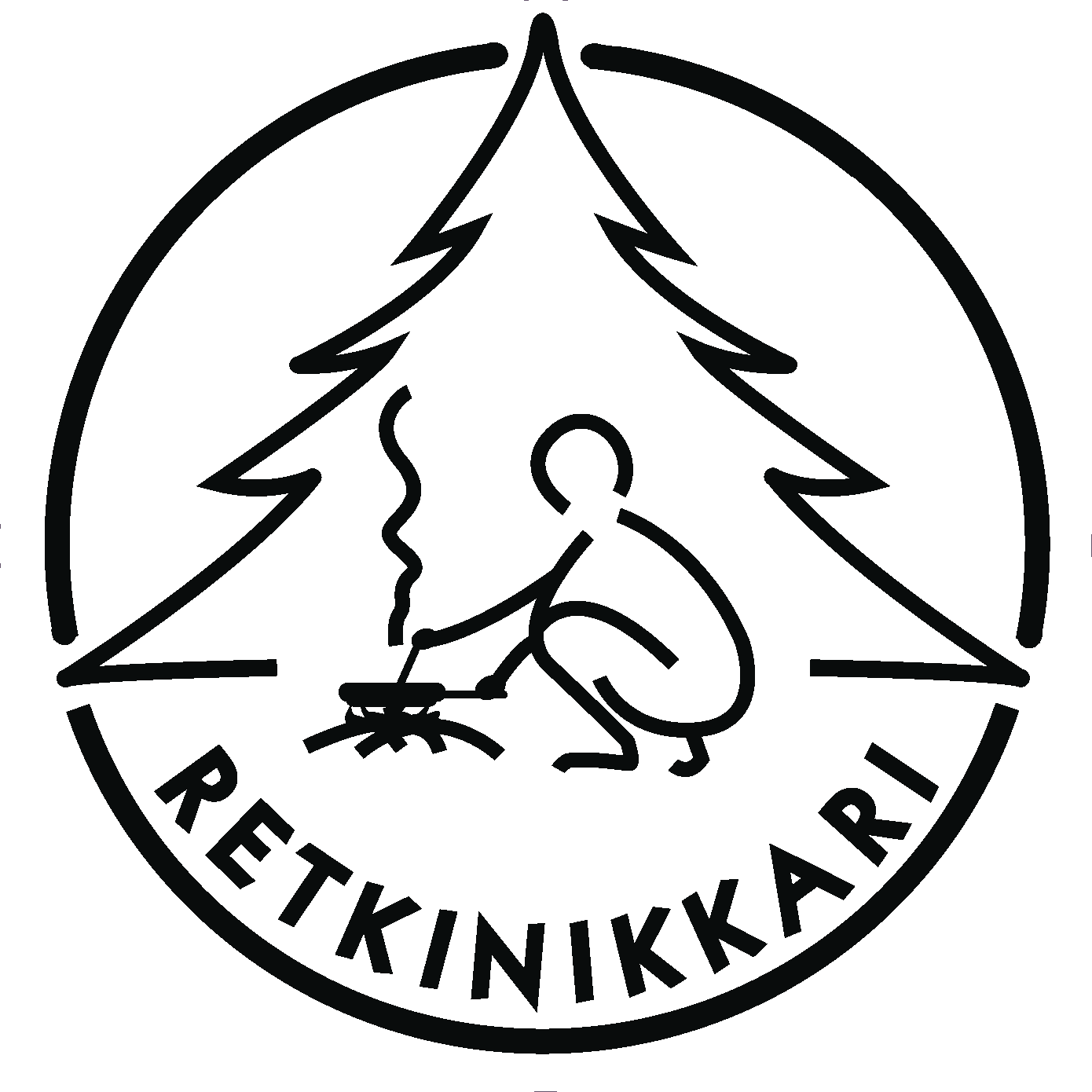
 Retkinikkari
Retkinikkari Facebook
Facebook Insta
Insta Twitter
Twitter
